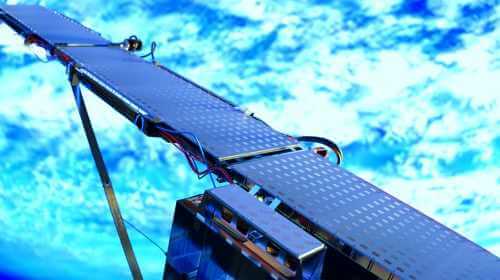How Hardware is Becoming Software in Space
Mar 21, 2022
Most of us have heard at least a little about Software-Defined Networking. SDN is an approach to network architecture that enables intelligent, centralized control. This is ‘programmed,’ via software applications. SDN helps operators manage the entire network consistently, regardless of the underlying network technology. The result is improved network performance and monitoring that resembles Cloud computing, rather than traditional network management. SDN brings advantages such as decoupling network control and forwarding (routing) functions, so that network control can be directly programmed. From a central management point, administrators can adjust traffic flows network-wide, to deal with changing needs. This agility allows admins to write automated SDN programs that quickly manage, secure, and optimize network resources. Finally, SDN is intended to offer open standards. The network is managed by SDN controllers instead of multiple, vendor-specific devices and protocols. Satellite operators are looking to extend these, and similar capabilities into space.
Software Defined Satellites
While there are prior developments leading up to Intelsat’s recent announcement, it is probably fair to say that real movement towards Software Defined Satellites was kicked off by Intelsat’s announcement in 2021 that it had placed orders for two Airbus OneSat GEO software-defined satellites. The satellites are expected to drive new applications and represent a vision for the future. They are expected to be delivered in 2023, promising improved connectivity for in-flight broadband service, through an ability to reconfigure beams as needed. What is driving the interest in software-defined satellites?
Traditional GEO satellites are launched for specific missions and a fixed design. These missions typically last 10 to 20 years, and once in orbit, they cannot be changed, even if demand has done so. Providing a satellite with a software-defined payload means operators can reconfigure the antenna beam on-demand. This will be programmable by using an uplink to send a new program to the satellite. A software-defined satellite should be able to modify beams, capacity, and power distribution dynamically. The term Software Defined Satellite is still being defined, but it generally means replacing traditional hardware components with software.
Being able to reconfigure the satellite, means the mission can vary throughout its lifetime and may be adjusted based on changing demands. This is particularly beneficial to the mobility market as the satellite can be programmed to provide coverage to moving targets such as aircraft and vessels. Beams can be reconfigured to provide coverage for temporary purposes such as natural disasters or remote operations. Inherent in software-defined satellites are SDR or Software-Defined Radios. These solutions can increase reliability by adjusting frequency if jammed, or adapting to terrestrial competition, or meeting frequency regulations in various countries. From a manufacturing standpoint, one software-defined multi-mission satellite can replace two or more single-mission satellites.
History of SDS
Spire Global was the first to release software-defined satellites, the ArduSat-1 and ArduSat-X (1U cubesats) in November 2013. They were released from the ISS (International Space Station) and began transmitting to Spire servers. The satellites employed SDR (software-defined radios) to enable testing and application development.
In 2015 Eutelsat announced its experimental Quantum satellite which featured flexible architecture and highly customizable beam coverage. Eutelsat Quantum was launched in July 2021 and provides Ku band coverage. Satellites developed under the Quantum umbrella will be faster and less expensive to build compared with current methods. They will use generic subsystems and equipment to enable scaling up production and efficiently controlling stock. The satellite will be able to completely transform, adapting to new commands relating to coverage, frequency band, power use, and even to change its orbital position. This makes it a universal satellite, able to service any region of the world and adjust to new business, rather than building a brand-new satellite. It can even be used to mirror or complement other satellites in orbit, which will likely transform fleet management and use of resources.
 Eutelsat-Quantum Credit: Airbus
Eutelsat-Quantum Credit: Airbus
Another step towards software-defined satellites came in February 2019 when Iridium completed the deployment of its constellation of 75 NEXT satellites into LEO orbit. See: What’s NEXT for Iridium. The NEXT satellites have a processor onboard with reprogrammable software that can be upgraded to deliver new, improved services based on market demand. Shortly afterwards, in March 2019, Lockheed Martin announced SmartSat, a software-defined satellite architecture intended to boost capability for payloads on pioneering nanosats.
A busy year, in May 2019, Airbus contracted with Inmarsat to design, their first-generation GEO Ka-band satellites, the Inmarsat GX7, 8 and 9. The satellites are first to be based on the Airbus OneSat software-defined satellite architecture. A bit later in the year, Boeing announced the new 702X family of software-defined satellites for SES’s O3b mPOWER MEO system. See: O3b MEO Fleet Still Growing. The O3b mPOWER is not strictly speaking a software-defined family of satellites, but it has some definable capabilities including a fully digitized payload and full electronic beam forming.
That brings us up to January 2021 when Intelsat contracted with Airbus to design, manufacture and deliver two Airbus OneSat spacecraft with software-defined architecture. These satellites are scheduled to be launched in 2023, and with them a new vision for satellite architecture. We will be awaiting the Intelsat launches with interest.
LEO and MEO
The advent of software-defined satellites for NGSO (non-Geosynchronous Satellite Orbit), is very timely. It will provide LEO satellites with the ability to communicate simultaneously with satellites using different RF links, and to mitigate costs for future communications requirements. For example, the industry anticipates constellations may shift from Ka band to Q/V band in the future. It will cost much less to reprogram frequencies through software, rather than having to send up new satellites with different hardware. As Adam Johnson the SmarSat director for Lockheed Martin put it: “Software is the asset, while hardware is the commodity.
Managing a NGSO constellation is complex because of the hundreds of ground stations these satellites use to direct traffic back to Earth and terrestrial networks. For such networks to work well, they must support centralized management and must be automated to provide effective operations. This is where the terrestrial SDN comes in, and where integration will need to take place with software-defined satellites. This integration will be critical to satellite participation in 5G networks.
Similar requirements apply to EO (Earth Observation) and military applications, which will be enhanced in the future with software-defined architectures. Does this mean software is going to disrupt the hardware market? Based on the current projections for new satellites, hardware is not going away any time soon. A growing number of new satellites are being positioned for more flexibility, without being software-defined. We are in the early stages of the transition, but the trend seems clear. Challenges remain. Not all RF components are easily virtualized through software. The closer to the antenna, the more challenging it is to digitize, but we can expect to see more software-defined satellites in the future.





